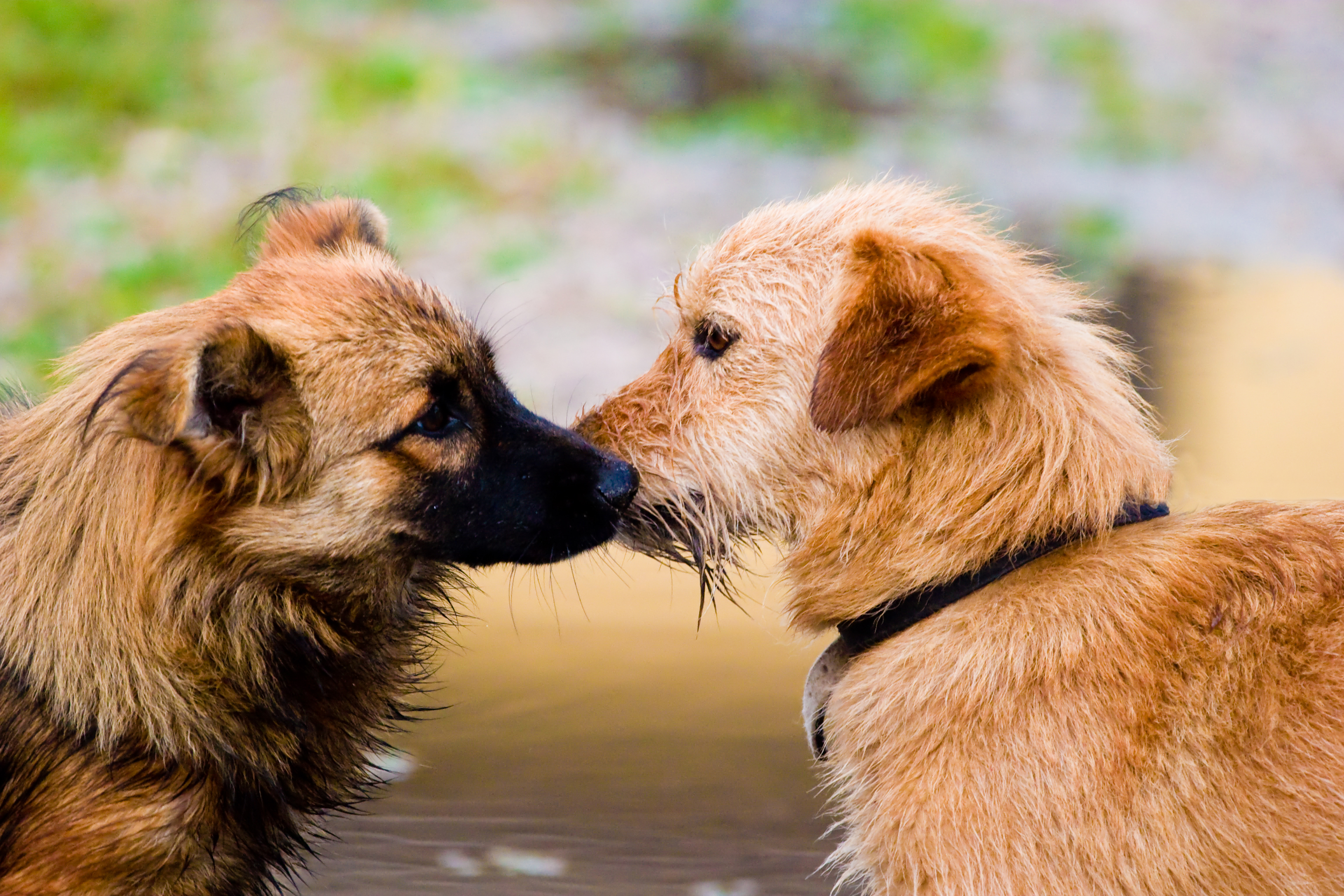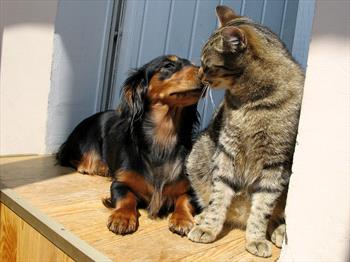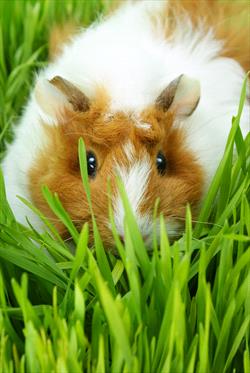
Photo courtesy of Deposit Photos
Introducing a new dog to the pets of your home can be a little tricky at first. You want your current pets and your new pet to live comfortably with everyone. Keep in mind that realistic expectations are important. Some dogs are not capable of getting along with other dogs. Some dogs have such a strong reaction to smaller animals that their instinct to chase and catch will override their ability to stay calm (this is known as a strong prey drive).
The key to ensuring good first interactions and blending the new family together is to separate everyone initially, let everyone get used to the new smells in the house, then closely supervise any interactions among the pets for a while, slowly increasing the amount of time your pets spend together. In order to avoid any inappropriate behaviors from your new pet or your current ones (e.g., urinating outside the litterbox, chasing, hiding), everyone should be comfortable together, not just tolerating each other.
Get your new dog checked by a veterinarian to ensure he is healthy and free of any diseases that may be contagious to your other pets. Discuss your concerns about the upcoming introductions with your vet so you can get as many tips and suggestions as possible to make adding a new pet a smooth transition.
Introductions to Other Dogs
When introducing a new dog to your current dog(s), the point is to avoid reaching the threshold where they start to growl and posture, not to react to it after it happens. Start by keeping the new one separated from the current resident(s) and let him sniff out the house alone. It is a good idea to start supervised visual contact without having them interact at first (i.e., keep the new dog leashed and across the room from the current and leashed dog(s) so they can see each other). Then while they are both leashed, supervise them together. You can also let them meet outside in the yard. If any growling or lunging aggressively occurs, you may need to re-separate them and back up a few steps for a while. If the dogs get along well but start to play too roughly with each other, take a break from playtime. If the aggression continues, separate them again, and follow this with supervised interactions until they are able to interact without getting too worked up.
Make sure each dog has plenty of his own food, toys, and water to help prevent fighting over these objects. Give each dog plenty of your attention and affection, even if that means separating them to do so. It is also a good idea to feed the dogs separately until they get used to each other, and then supervise their meals very closely.
Understand that there is a honeymoon period when a new dog comes into the home, during which the new dog slowly becomes more comfortable and behaviors that were not evident at first can emerge.
Over time, creating a daily routine that involves time together, time apart, and exercise will go a long way towards keeping all pets comfortable and happy. Exercising them together by walking them on separate leashes, possibly with one person to each dog, is a great way to help them get used to each other in an enjoyable manner. Always remember to reward good behavior.
When the New Dog Is a Puppy
Introducing a new puppy to your pet family is a little bit different than introducing an adult dog. Puppies generally have a harder time interacting properly in social settings because they haven’t learned how. Examples include playing too roughly and chewing on everything, including other pets. Puppies learn how to behave by being taught by other dogs, such as their mother and siblings. So when you bring an energetic, rough-playing puppy home to meet your other pets, you will likely notice that the other pets seem almost annoyed by these interactions. An older dog may nip or growl at the new puppy when the puppy crawls on him and tugs on his ears. This is technically normal, but needs to be carefully monitored as it is difficult to know whether this is a “Hey, kid, get off me…” type of warning or truly aggressive behavior. Introducing the puppy to a cat is similar: the persistence of a puppy can lead to what appears to be rude behavior by the cat (swatting at the puppy or hissing), but may be the cat trying to teach the puppy what is appropriate behavior. Yelling at your adult animal for correcting the puppy will only create more tension and may lead to a more permanent dislike of the new pup by your current pets. Remember to keep everyone distracted with their own treats/toys during their time together.
Your current dog may feel uncomfortable around a puppy who does not really understand the adult dog’s communication, and so the puppy doesn’t realize the dog doesn’t want to interact. If the puppy goes near the adult and the adult gets up and moves away, that is clear communication that the adult doesn’t want to be disturbed. If the adult does that and the puppy follows the adult around anyway, the puppy is not understanding the adult’s communication. If the puppy jumps on the adult, the puppy is really not understanding his communication; this is akin to a strange and annoying child coming up to you in your home and ignoring your asking him to play outside and leave you in peace. The adult dog will snap at the puppy or raise his lip, which is a higher level of communication. The adult dog has raised his “go away and leave me alone” to “go away and leave me alone, or else…” This is good communication and should not be punished. If the puppy doesn’t understand the adult’s communication to go away, the adult needs to go to you for help instead.
Praising the adult dog around the puppy helps. If the puppy comes up to the adult, the adult needs to learn that good things can happen: You can praise him for interest in the puppy and if he wants space (e.g ., looks or turns away from the puppy), call the puppy away and throw a treat to the adult while giving a treat to the puppy for coming to you. To the adult, this means that something good happens if he lets the pup near him. For the pup, recall is being reinforced frequently. Also, the puppy can start shortening interactions with the adult and come to you for stimulation. If you do not want to do something with the puppy, you can redirect him to toys that he can play with by himself.
Everyone needs personal space. Consider crate training both dogs and making the crate a safe haven where the other dog is not allowed. Then the adult can go and get personal space. If you are not sure that the puppy has learned to keep away from the adult dog’s crate, take the puppy elsewhere or give him time in his own crate with a chew treat/toy if he has already learned to like his crate.
Because puppies are generally more fragile than adults, after initially separating everyone start with crating the current dog or putting the current cat behind a baby gate so the puppy can sniff the area and you can see how your current pets will interact. Once you move on to the pets being in the same room, hold the puppy instead of putting him on a leash. During supervised interactions, sit on the floor with the puppy in your lap for several interactions before allowing the puppy to roam and meet your current pets without your help. Continue to supervise and separate feeding and toys for many interactions before letting them spend any time alone together. As with other interactions with cats and dogs, if any aggression or signs of fear are noted, go back to separation and re-introduce everyone more slowly the next time.
Be sure to limit the puppy’s time with your other pets so they get a good break. Having a new baby of any kind in the household can be tough on an older pet because of the energy required in spending time with and helping to raise a puppy. Make sure to give your current pets plenty of time alone with you so they don’t feel left out.
It’s helpful to take your puppy to obedience training so he can interact with other unknown dogs and learn appropriate behaviors.
Dog and Cat Nose to Nose

Photo courtesy of Deposit Photos
Introductions to Cats
For new dogs that are calm or laid back, place them in a kennel or crate and allow your cat to check out the outside of the crate for as long as he wants. The dog should not be growl or try to get to the cat. For a dog that is more excitable, has separation anxiety, or has a history of aggression towards cats, place him on a leash next to you in the house and let the cat come over at his leisure. Consider feeding the cat at a safe distance during this time so your cat will recognize that he can eat around the dog without being chased.
Even once your dog and cat show that they can interact positively, continue to keep your new dog on a leash and supervise interactions for a while. The leash will help you prevent unexpected chasing or signs of aggression from the dog. During these interactions, your new dog can be kept busy and distracted with his own food, treats, chew toys, and loving attention from you. Keep yourself calm as well. Do not yell at, hit, or punish your dog or cat if things don’t go well on the first try. Reward everybody for being calm and polite to their new roommate. It is important during these interactions that your cat has a place to escape if he feels scared or threatened. Hiding under furniture, a tall cat tree/perch, or ideally, a baby gate that he can jump over or crawl under to get to another room are all great options and should be available for your cat for a long time, even after your dog has proven he is no threat to your cat.
Once your new dog is settled in, be sure to allow your cat to regularly explore the house alone for all of the new smells your dog will bring with him. This may involve putting the dog in a kennel or a separate room for a little while. Of equal importance is that your cat should also have a dog-free space he can go to as needed whenever he wants.
If your new dog has a history of aggression towards cats, or if he shows aggression towards your cat during his interactions, you may want to consider a basket muzzle during their supervised interactions and avoid time alone with each other. As stated above, some dogs have such an intense prey drive that they can’t overcome those instincts no matter how hard they try.
Guinea Pig

Photo courtesy of Deposit Photos
Introductions to Prey Animals
As with interacting with a new cat, interacting with smaller pets such as hamsters, guinea pigs, birds, or rabbits needs to be heavily supervised from the beginning. Some dogs are not capable of overcoming their prey drive and may always need supervision around these types of animals because their natural instinct may be to hunt them. If in doubt, keep your new dog as distracted as possible with treats and chew toys and always reward him for staying calm.
More Tips
- Teach your new dog some tricks that will be a distraction during an excitable time and to keep him busy. Examples of these include “sit,” “stay,” and “leave it.” “Sit” and “stay” are extremely helpful to learn because you have given your dog a new job- to sit or stay- that he should be rewarded heavily for when successful. This new job will keep him from chasing and stop him from further poor behavior when he interacts inappropriately with another pet. “Leave it” is a helpful new job because it will teach him to drop what he is playing with, such as your current dog’s favorite toy (or medication), and hopefully avoid an inappropriate interaction with the other pet. If your current dog hasn’t learned these tricks yet, teaching him can also be helpful, especially if the new dog is a puppy. It will help your current dog stay calm when trying to interact with someone new.
- Monitor your pets’ body language throughout each interaction. If you get to a point where one pet acts uncomfortable or aggressive, it is time to separate them and re-start from the point where everyone was comfortable. If one pet is uncomfortable/aggressive when in close contact, use a leash on your new dog and supervise everybody with the new dog separated but able to see the other pet. If that goes well, gradually bring everybody closer together without physically interacting, as long as everyone remains comfortable. Any signs of aggression or fear should warrant further separation until pets can be in the same area without interacting and without inappropriate behaviors. Do not physically bring pets together until they can interact separately but within view of each other. Stay positive and relaxed and always reward the pets when they act calmly and appropriately.
- Medications can help with decreasing anxiety, or in some cases, aggressive tendencies, but they do not work immediately, and they don’t solve the problems that initiate the fear/aggression. The better option is to identify what triggers your pet to feel or act a certain way and specifically work on, or when necessary avoid, those issues. Once you have done this, you may notice such positive changes in your pets that medications can be completely avoided. If you have taken all the steps to improve your pets’ wellbeing and issues persist, talk to your veterinarian about what to do next. While medications can be helpful, managing the environment and your pets’ interactions are necessary for these types of medications to be effective.
- Pheromone diffusers can be a great way to give your new dog a boost of comfort in his new environment. Dog appeasing pheromone (DAP) is released from a plug-in style diffuser that mimics the pheromones released from their mother during puppyhood. Although there are no published studies backing this up, most veterinary behaviorists believe these diffusers are useful in dogs that experience anxiety or fear, and for those settling in to new homes.
- Always reward good behavior for all animals involved. When it’s time to separate the animals, take the treats away. That way they can associate spending time together with treats. Remember to keep all pets busy with fun activities, such as chew toys, during interactions, assuming there is no previous issue of aggression over food or toys. This way they are distracted by things more interesting than each other and will associate spending time together with fun and positive experiences.
Originally published on Veterinary Partner 8/14/2018. Reposted with permission